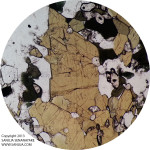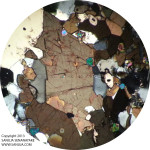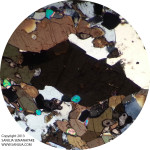
Arsenopyrite
Not and ore, but common sulphide associated with ores Continue reading Ore Minerals and Rocks
Also known as Geology, Geosciences, etc. It is a science that deal with Geologic materials and processes which made them. A multidisciplinary field in which also includes Geophysics, Hydrology, Structure and Civil Engineering and many more.

Not and ore, but common sulphide associated with ores Continue reading Ore Minerals and Rocks
In Structural Geology, the orientations of geological features are extremely important. Field Geologists record strike and dip of structural features. These data later can be used for analysis and interpretation. The right hand rule is an arbitrary standardization used by some Geologists. It is not a universal rule; hence the term “right hand rule” is a misnomer. Continue reading Right Hand Rule in Geology
Index: B | C | E | G | H | K | M | O | P | Q | S | T | Z | Footnotes
Notes:
–wiki
Notes:
–wiki
Notes:
–wiki
Notes:
–wiki
Notes:
–wiki-Calcite
–wiki-Dolomite
Notes:
–wiki
Notes:
–wiki
Notes:
–wiki
Notes:
–wiki
-info here
Notes:
–wiki
Notes:
–wiki
Notes:
–wiki
Notes:
–wiki
Notes:
–wiki
Notes:
–wiki
Notes:
–wiki
Notes:
–wiki
Notes:
–wiki
Notes:
–wiki
Birefringence: +0.009
Notes:
–wiki
Birefringence: 0.016 – 0.023
Notes:
–wiki
Notes:
–wiki
Notes:
–wiki
Warning!
I am not sure if these images are actually titanite. Please let me know if you can confirm.



Notes:
–wiki
Notes:
–wiki
A – denotes accessory minerals. Colours under the microscope should be noted both under PPL and XPL.
Extinction angle and Interference Colours (Birofingence) is always observed under XPL. Some minerals such as dolomite verses calcite are difficult to identify without a hand sample. These images are NOT a replacement for hands on lab experience. If you find any errors, please contact me.
You may also reference Mineralogy Media Library.
Microscope: Nikon H550S
Camera: Samsung 8 MP, 3264×2448 pixels
Date(s): 29-March-2013 to 12-April-2013
Samples: Epoxy has an R.I. of 1.55 +/‐ 0.01; thin sections varies between xx-xx μm
Image Size: 1500 x 1500 pix
File Name: Mineral name, Type of polarity and Thin section number (if more than one image, the file number); For example; min_kyanite_xpl_CK192_2.jpg.

Colour balance issues; since it was extremely hard to calibrate the digital camera to reflect the true colours and due to various other factors, the colours in these images may not be perfectly accurate. For example, the Calcite in PPL suppose to look clear.
I recently came across a textbook, Basic Geological Mapping1, which is written for novice users. I found few interesting things in the introduction chapter that one might argue “kind of odd” for a well-written Continue reading Odd advice for a Field Geologist
As a student, I am fascinated with economically important ore minerals such as diamonds. If we look beyond the jewelry aspect, diamonds are used in variety of applications. Diamonds are made of pure native carbons. Pure carbon can exist as a mineral in two different variations in Continue reading Diamonds beyond jewelry